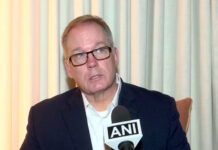
PATERSON, N.J.: Mention America’s historic landmarks and most people will envision battlefields, statues or beautiful scenery, not a crumbling, graffiti-covered shell of a ball field surrounded by abandoned cars, broken glass and piles of garbage.
The years of neglect can’t erase what Hinchliffe Stadium once was, a hub of activity that in its heyday was filled to capacity for Negro League baseball games featuring future Hall of Famers Satchel Paige, Larry Doby and Monte Irvin and teams like the New York Black Yankees, the New York Cubans and the Newark Eagles.
The once-grand Art Deco stadium earned designation last month as a national landmark – less than two years after the nearby Great Falls, a powerful 77-foot waterfall that helped fuel the Industrial Revolution, became a national park.
The twin successes have stirred pride in this struggling working-class city beset by decades of crime and financial difficulties. Now, those who fought to gain recognition for the two sites face new challenges in trying to turn them into major attractions and an economic boost for Paterson, whose textile mills in the late 19th and early 20th centuries earned it the name Silk City.
The National Park Service is working to acquire land around the waterfall from the city and other owners and to develop a plan to make the park more visitor friendly, said Darren Boch, the park superintendent.
An audio tour will be available this month. It is narrated by NBC “Nightly News” anchor and New Jersey native Brian Williams, with contributions from Paterson native and New York Giants wide receiver Victor Cruz and Pulitzer Prize-winning author Junot Diaz. It addresses the confusion visitors may feel visiting a park built around a waterfall in the heart of a densely packed city of nearly 150,000, less than 15 miles from Manhattan.
“For a lot of Americans, the idea of a national park evokes the likes of Yellowstone or Yosemite, and like them, this national park features a spectacular natural wonder,” Williams narrates.
He speaks further about how Alexander Hamilton, the nation’s first treasury secretary, envisioned harnessing the power of the falls to create the nation’s first planned industrial city in Paterson, helping to transform America from an agrarian society into an industrial powerhouse capable of breaking free from British control.
Generations of immigrant workers were employed in factories powered by energy from the Great Falls, where water from the Passaic River rushes over at a rate of 2 billion gallons per day, making it the second largest waterfall east of the Mississippi River, by volume, next to Niagara Falls.
“That’s what sets apart the visitor experience here,” Boch said. “You have the two experiences: a natural wonder in an urban landscape that goes to the heart of the industrial American experience.”
Those who worked for years to save the ballpark, which was also famous for midget car racing and fielded generations of local school teams, hope to one day have it included in the footprint of the national park. It’s just as important a part of American history, they say, though it represents a different era. It’s one of only a handful of Negro Leagues stadiums still around, according to the group Friends of Hinchliffe Stadium, which fought for years to save the structure.
The list of baseball greats who played there – to integrated audiences in 20th century, segregated America – include 11 players in the Major League Baseball Hall of Fame. Among them are Doby, who went to high school in Paterson before becoming the first African-American player to integrate the American League, and Irvin.
Irvin recounted recently how thrilled he had been in 1938 to set foot in Hinchliffe Stadium for the first time as a 17-year-old tryout for the Newark Eagles and to hear someone call out to his idol, Buck Leonard, “Hey, Buck, who is that youngster?”
“I want people to know that it was one of the famous parks where the Negro Leagues played, some of the biggest stars played there,” Irvin, now 94, told The Associated Press from his home in Houston. “Maybe baseball can again become very prominent at the park.”
Paterson city officials hope so, too.
Hinchliffe is owned by the school system, which shut it down in 1997 because it could no longer afford to keep it up.
Renovation cost estimates reach as high as $20 million to bring the park back to life. The City Council voted to recognize it as local landmark a few weeks ago and have allocated $1.5 million for its immediate stabilization, Mayor Jeffery Jones said.
The next challenge, the mayor and others have said, will be trying to raise the rest of the funds from private donors, grants and the state to restore the stadium to its former glory.
The efforts in Paterson to win national status for the falls and the ballpark were aided by a growing push to recognize the nation’s quieter heroes: the immigrant laborer or the Negro Leagues player who may not have had Jackie Robinson’s name recognition but fought alongside him to change the status quo, said Giacomo DeStefano, director of the Paterson Museum.
The move to get the waterfall designated a national park also dovetailed with the recognition by the National Park Service that it needed to attract more minorities to parks to sustain the system in an increasingly diverse America, said Leonard Zax, president of the Hamilton Partnership for Paterson, which lobbied Congress for federal recognition of both sites.
With nearly 60 percent of Paterson’s population of Latino descent and more than 30 percent African-American, the city fit in perfectly with the Park Service’s vision of a “`national park for the 21st century,” Zax said.-AP






